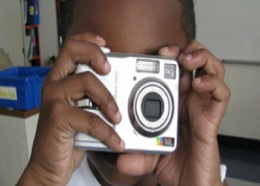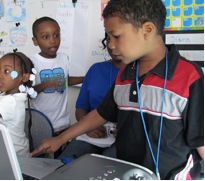What's New for 2010
You can see some examples of student work here. The 2010 program enrolled 85 children aged 5 - 15 for one month, July 5 - 31, 2010, thanks to a grant from the Wyncote Foundation. More than 35 children are attending our all-day program this summer-- with themes including "All About Pop (Music)," "Monster Media," "Video Game Design" and "Understanding Celebrity Culture." Fifty children attend am AM program in academic remediation to work on writing, reading and math and enroll in our PM program. There, children get to learn about mass media and popular culture with activities that involve lots of teamwork and collaboration. Children develop effective communication skills and get plenty of hands-on work with digital media-- especially our beloved Flip video cameras!
One group of students has been planning a public service announcement. We post student videos to our YouTube channel. See one child present her ideas here:
Staff Training for PVK Instructors, Summer 2010
We offered a month-long training program to prepare instructors for their work with children. David Cooper Moore and Renee Hobbs are writing a book to share our innovative approach to staff and curriculum development.
Focus of the 2009 Program
The summer learning program was offered to 77 students in Grades K – 5 from 12 – 4 p.m. from Monday through Thursday during the month of July, for a total contact time of 64 hours.  Children ages 6 -12 who reside in Philadelphia and attend the Russell Byers Charter School were eligible to participate. The program was designed to make a connection between school and contemporary culture as lived experience, using mass media, popular culture and digital technology to engage urban children in reading, writing, speaking and listening activities. Students came from 41 neighborhoods across Philadelphia. Many students
live in the neighborhoods of Kingsessing, West Park, and Point
Breeze/Grays Ferry. 70% of students are eligible for federal free and
reduced lunch programs. Unfortunately, only 53% of students reached
proficiency level on the state standardized reading test in 2008.
Children ages 6 -12 who reside in Philadelphia and attend the Russell Byers Charter School were eligible to participate. The program was designed to make a connection between school and contemporary culture as lived experience, using mass media, popular culture and digital technology to engage urban children in reading, writing, speaking and listening activities. Students came from 41 neighborhoods across Philadelphia. Many students
live in the neighborhoods of Kingsessing, West Park, and Point
Breeze/Grays Ferry. 70% of students are eligible for federal free and
reduced lunch programs. Unfortunately, only 53% of students reached
proficiency level on the state standardized reading test in 2008.
A wide array of digital and media literacy activities included focus on different media forms and genres, including newspapers, advertising, movies, the Internet and video games. For example, activities exploring advertising included critical viewing of TV commercials to identify persuasive rhetorical strategies; exploring readings about advertising history and the advertising business to learn about the jobs involved in creating ads. See the Sample Activities for a display some of the many lesson plans used in the program. Watch children's videos at our You Tube Channel.
Summer Learning 2009 Program Highlights
Purple Team (Grades K-1)
Students took on the role of reporters, interviewing their classmates about their favorite things and publishing the information online using the Wikispaces software. The Purple Team also made a visit to the studios of Sprout, the 24-hour cable network for preschool children, where they learned about how television programs are made. The Purple Team's study of media culminated in the creation and marketing of an original product: a sneaker brand called "Minjos." The students designed the shoe, its packaging, and even created a 30-second television commercial. Teacher: Nicole Warneke.
Red Team (Grades K-1)
The Red Team students became experts at being “TV Smart” as they learned how to watch television using a critical lens. Students learned to differentiate between shows designed to entertain, to inform, or to persuade, and to differentiate fiction and non-fiction programs. In addition, children developed an understanding of narrative structure by viewing clips of news programs, commercials, and other shows and then jumping into the “writer or filmmaker chair” where they got to finish the story, using prediction skills to imagine how story really ends. These practices showed the students they could anticipate story endings and write their own.  Children were featured in many informal videos where they described their understanding of computers, media celebrities, and other topics. To display their newfound "TV smarts" they used their 6 and 7-year-old voices to create a short film as a final project. Teacher: LaShon Fryer.
Children were featured in many informal videos where they described their understanding of computers, media celebrities, and other topics. To display their newfound "TV smarts" they used their 6 and 7-year-old voices to create a short film as a final project. Teacher: LaShon Fryer.
Green Team (Grades 2-3)
The Green Team explored the many different types of television programs on the air, learning about the formal category names for programs: news, reality shows, comedy, drama, action-adventure, sports and other types of shows. They also learned about the TV and film ratings system and held a debate about whether or not children should watch R-rated movies. The Green Team became the summer program's official reporters, and produced an original television newscast, reporting on the activities of the program as a whole with students playing the parts of reporters and anchor. Teacher: Rachel Hobbs.
Orange Team (Grade 4)
In studying informative media, The Orange team compared and contrasted news with oral tradition as a means to gain information. In studying persuasive media, the team took a critical view of cigarette advertising, and constructed their own anti-smoking public-service announcement.  Finally, while studying entertainment media, students unleashed their team's musical talent by forming "The Orange Team Band," and composing and performing an original Powerful Voices for Kids theme song. Instructor: Nuala Cabral.
Finally, while studying entertainment media, students unleashed their team's musical talent by forming "The Orange Team Band," and composing and performing an original Powerful Voices for Kids theme song. Instructor: Nuala Cabral.
Blue Team (Grade 4)
The Blue Team used controversy and popular culture in the news to conduct research on issues of celebrity representation in news media. The team studied the case of Chris Brown-- the chart-topping pop singer who made headlines in the summer of 2009 when he was accused of badly beating his girlfriend and fellow pop star Rhianna. The fourth-graders' study of the Chris Brown controversy culminated with a mock-trial. Students were challenged to understand the idea from a media perspective. Students studied different perspectives on the event from various points of view, including the apology video that Brown posted to YouTube. The Blue Team used their newly-gained understanding of this important issue to take an advocacy stand on Brown’s actions. Instructor: Henry Cohn-Geltne r.
r.
Yellow Team (Grade 5)
The Yellow Team used the unique medium of the video game to explore a controversial current event. While the Powerful Voices for Kids camp was in session, a local news story captured the attention of city residents when charges of racism were leveled against the Valley Swim Club when they canceled the swimming privileges of a nearby day care center whose children are predominantly African-American. The Yellow Team began their investigation with an analytical reading of two news articles on the event, carefully reading through them as a group, and discussing the new information found in each sentence. Armed with this expertise, students used the kid-friendly programming tool Scratch to author an interactive activity about one portion of this controversial news event. Students developed a video game to imagine other possible outcomes to the event if the people involved had made different choices. For example, one child created a simple interactive that showed the many different excuses used by the director of the Swim Club while the viewer sees microphones and cameras getting closer and closer. Instructor: John Landis.
Silver Team (Grade 5)
Silver Team students were concerned about the quality of local news coverage and its emphasis on crime and violence. The class worked together, collaboratively authoring a letter to the producers of local television news. The students felt strongly that local TV news focused too much on “robberies and deaths,” and expressed a concern that “kids are watching and it’s frightening to children.” The letter asked that the news focus instead on “the economy, democracy, good deeds, and nutrition.” The Silver Team produced their letter as a short video and delivered it to the news department of a local ABC affiliate. They also visited a local TV news station to watch the noon news program in live production. Instructor: Aggie Ebrahimi.